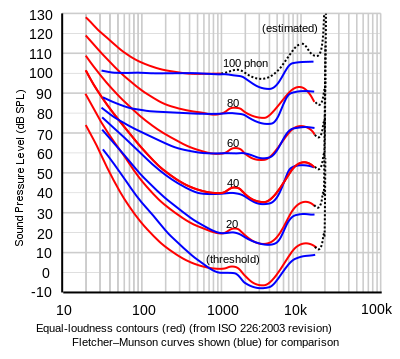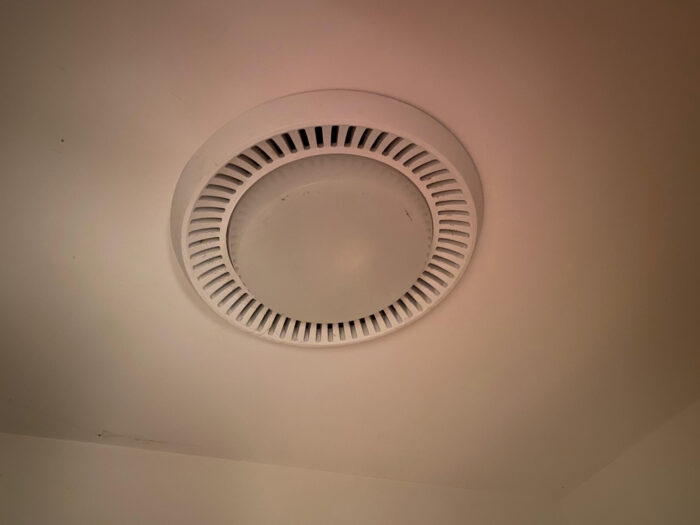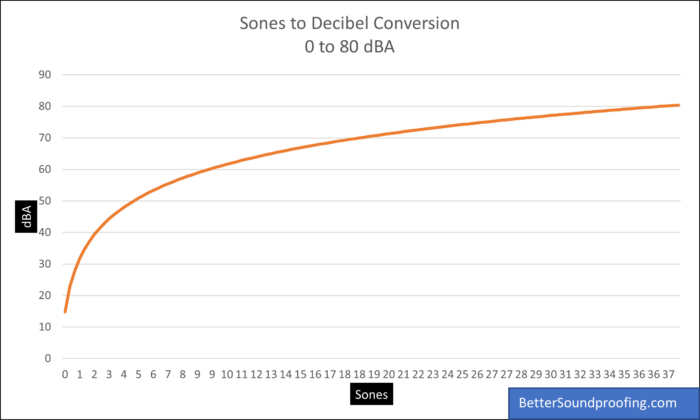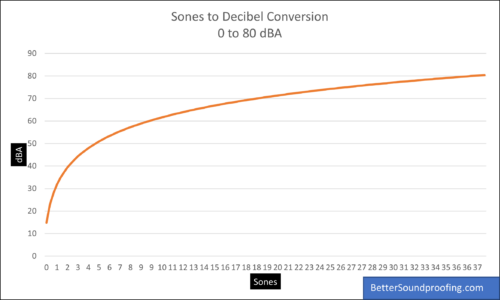Most people have at least a rough idea of what a decibel is. But when a measurement of noise level is expressed in sones, we might be a little confused. Here is the Concise Oxford Dictionary definition.
Sone: a unit of subjective loudness, equal to 40 phons.
Phon: a unit of the perceived loudness of sounds.
Not very helpful? Please read on for real information that you can use when confronted with noise levels expressed in sones.
What Exactly is a Sones Rating?
Most sound levels for equipment such as lawn mowers or compressors are given in decibels. But some electrical or mechanical equipment like range hoods and bathroom fans give sound value in sones. If you know what a sone represents in the real world (See chart below.), you will be better able to know what the machine will sound like.
Sones are measured on a linear scale. This means that doubling the number of sones doubles the noise level. 2 sones are twice as loud as 1 sone and 4 sones are twice as loud as 2 sones. In some ways sone noise levels are easier to understand then decibel levels.
Decibel levels use a logarithmic scale like the Richter earthquake scale. A simplified explanation is the 3 Decibel Rule. For every 3 decibel increase or decrease, you are adding or dropping 50% of the sound pressure levels your ears are exposed to.
The Meaning of Sones
The sones rating system is a way to measure or express perceived loudness. Sones are not a physical measurement like decibels. It is a system to tell how loud a sound feels to humans. The human test subjects used to develop the sones rating system were asked to describe how loud a sound felt.
A sone rating for sounds may be more useful because humans sense higher and lower sound wave frequencies differently. Most people hear high frequency sound waves better than lower frequencies. Meaning our perception of sound level is related to the frequency of the sound wave.
For instance, a 20 decibel whisper delivered at 100 Hertz (frequency measurement) cannot be heard by the human ear. Raise the same 20 decibel whisper to 500 Hertz and it becomes audible.
The Encyclopedia Britannica describes sone as follows:
sone, unit of loudness. Loudness is a subjective characteristic of a sound (as opposed to the sound-pressure level in decibels, which is objective and directly measurable). Consequently, the sone scale of loudness is based on data obtained from subjects who were asked to judge the loudness of pure tones and noise. One sone is arbitrarily set equal to the loudness of a 1,000-hertz tone at a sound level of 40 decibels above the standard reference level (i.e., the minimum audible threshold). A sound with a loudness of four sones is one that listeners perceive to be four times as loud as the reference sound.
Sones Chart – Sones, Pascals, Decibels (dB)
This chart from Wikipedia shows the comparison of sones, pascals, and decibels for a few chosen sounds. The article also provides more details about sones.
| Description | Sound pressure | Sound pressure level | Loudness |
|---|---|---|---|
| pascal | dB re 20 μPa | sone | |
| Threshold of pain | ~ 100 | ~ 134 | ~ 676 |
| Hearing damage during short-term effect | ~ 20 | ~ 120 | ~ 256 |
| Jet, 100 m away | 6 … 200 | 110 … 140 | 128 … 1024 |
| Jackhammer, 1 m away / nightclub | ~ 2 | ~ 100 | ~ 64 |
| Hearing damage during long-term effect | ~ 6×10−1 | ~ 90 | ~ 32 |
| Major road, 10 m away | 2×10−1 … 6×10−1 | 80 … 90 | 16 … 32 |
| Passenger car, 10 m away | 2×10−2 … 2×10−1 | 60 … 80 | 4 … 16 |
| TV set at home level, 1 m away | ~ 2×10−2 | ~ 60 | ~ 4 |
| Normal talking, 1 m away | 2×10−3 … 2×10−2 | 40 … 60 | 1 … 4 |
| Very calm room | 2×10−4 … 6×10−4 | 20 … 30 | 0.15 … 0.4 |
| Rustling leaves, calm breathing | ~ 6×10−5 | ~ 10 | ~ 0.02 |
| Auditory threshold at 1 kHz | 2×10−5 | 0 | 0 |
Loudness and Sones
Sones measure loudness of sound. Sone values are different then decibel measurements because they take into account the frequency and level dependency of human hearing. The following YouTube video produced by Siemens will help introduce you to loudness and sones. Along with applicable graphs, charts, and examples.
Loudness of Sound
Decibels represent the amplitude of a sound. Sones represent perceived loudness of sound which includes sound wave frequency as measured in Hertz. The lower limit of the human hearing threshold is frequency dependent producing different sone hearing values at different frequencies. For example: a 10 decibel sound (tone) at 50 Hertz is inaudible to humans, but the same 10 decibel tone at 5000 Hertz is clearly audible. Although the decibel value is the same, the perceived loudness is much different because of the frequency.
Frequency is a measurement of the total number of sound waves produced in one second. Low frequency sounds are under 500 Hertz such as ocean waves and avalanches. High frequency sounds are usually over 2000 Hertz like whistles and finger nails on a chalkboard.
Another example of the perceived loudness of sound. All of the following sounds are rated at 85 decibels.
- Passing diesel truck. Low frequency range.
- A snow blower. Mid-frequency range.
- Your smoke alarm. High frequency range.
No one needs the sone numbers to know which sound is perceived loudest.
High Frequency Hearing Loss
High frequency hearing loss quite often occurs in people as they age. Also in people exposed to loud noise. Most anyone with this problem can follow normal conversation but will have trouble with certain consonants (s, h, and f), which are spoken at a higher pitch. Also some words or sounds may sound muffled. Low frequency hearing loss is much more rare.
The perceived loudness of sounds is decided by panels of people with normal hearing. The sone rating system of loudness could be less relevant to someone with high frequency hearing loss because of the inability to hear well and separate different sounds.
Equal Loudness Contour
The following graph from Wikipedia – Equal Loudness Contour helps explain the identical perceived loudness of sounds at different decibel levels and different frequencies.

The original research into how the ear hears different frequencies at different levels was conducted by Harvey Fletcher and Wilden Munson in 1933. They developed the Fletcher Munson curves that have been improved upon, but are still in use today. These curves are equal loudness contours where every sound on each line will have the same perceived loudness.
To achieve this consistency, the sounds are generated for the ‘hearing jury’ at different combinations of decibels (sound pressure level) and Hertz (frequency). As you can see from the graph, the loudness of each contour is expressed in phons.
Defining Loudness – Phons & Sones
Phons are used to measure the loudness level. But 2 sounds that have equal intensity do not necessarily have equal loudness. The phon represents equal loudness to a 1000 Hertz tone. Which is why you see the sound curves in the chart above.
Example: A 90 phon tone is equally as loud as a 1000 Hertz tone at 90 decibels. If a 125 Hertz tone is 47 phons, it is as loud as a 1000 Hertz tone at 47 decibels.
To convert phons to sones, use this formula: Sones = 2(phon-40)/10
Sones are a measure of loudness itself. Sone values are generally preferred to phon values because sones are a linear scale. If the sone value triples, the perceived loudness triples. This is consistent for the entire frequency range.
The phon scale is logarithmic and less intuitive. An increase of each 10 phons represents a doubling of perceived loudness.
Loudness Standards
Just in case I haven’t confused you enough already, there are also 3 different standards for sone calculation.
- Stevens Mark VI & Mark VII. Developed by Harvard professor Stanley Smith Stevens. Mark VI in 1961. Mark VII in 1975.
- ISO – 532B. This standard was first published in 1975.
- DIN 45631. Maintained by the German standards organization Deutsches Institut fur Normung (DIN).
As you might imagine, the methods used for each of these standards can produce different results. If the device you are buying has a sone rating, it should also tell you which standards association it is using. For more information, please see Siemens Sound Quality Metrics: Loudness and Sones.
Sones of Bathroom Fans and Range Hood Exhaust Fans
Sones are the industry standard noise measurement for fans. Almost every range hood and bathroom fan mentions its sone rating.
Bathroom fans range from 0.3 to 4.0 sones.
Bathroom Fans, Sone Ratings
| Sones | CFM – Cubic Feet per Minute | |
| Quietest Residential Bathroom Fans | 0.3 – 0.8 | 50 – 80 |
| Typical Residential Bathroom Fans | 0.8 – 1.2 | 80 – 110 |
| Large Residential Bathroom Fans | 1.5 – 2.5 | 110 – 140 |
| Typical Commercial Bathroom Fans | 1.0 – 3.0 | 100 – 300 |
| Large/Loud Commercial Bathroom Fans | 3.0 – 7.0 | 300 – 1900 |
 Noisy bathroom fan
Noisy bathroom fan
Range Hood Exhaust Fans, Sone Ratings
Range hoods typically produce between 3 and 7 sones of sound. With some as quiet as one sone and some as loud as 13 sones. The following comparison table will help you understand the volume of a sone and comparison to decibels.
- 0.3 sones = 11 decibels Sound of a pin dropping
- 1.0 sones = 28 decibels Sound of a whisper
- 2.0 sones = 38 decibels Sound of a babbling brook
- 3.0 sones = 44 decibels Sound of bird calls (not crows)
- 4.0 sones = 48 decibels Sound of a refrigerator
- 5.0 sones = 51 decibels Sound of a refrigerator
- 6.0 sones = 54 decibels Sound of a refrigerator
- 7.0 sones = 56 decibels Sound of normal conversation
- 8.0 sones = 58 decibels Sound of normal conversation
- 9.0 sones = 60 decibels Sound of normal conversation
- 10.0 sones = 61 decibels Sound of normal conversation
- 11.0 sones = 63 decibels Sound of normal conversation
- 12.0 sones = 64 decibels Sound of normal conversation
- 13.0 sones = 65 decibels Sound of normal conversation or normal laughter
As you can see, most new range hoods and bath fans are fairly quiet. Older fans, or fans that are installed improperly will be noisier. For more information, please see our articles The Quietest Range Hood of 2022, and How to Fix a Noisy Bathroom Fan.
Note how much difference there is between decibels at lower sone ratings, and how close the decibels are at higher sone ratings.
Other Devices with Sone Ratings
The other 2 appliances that may regularly use sones as a sound rating are:
- Microwaves.
- Down Drafts Ventilation System.
Although even this is a rare occurrence.
Converting Sones to dB (Decibels)
The formula for converting sones to decibels is:
dB = 33.2*log10(sones) + 28
Examples: 33.2*log10(1 sones) + 28 = 28 decibels
33.2*log10(3 sones) + 28 = 43.84 decibels
The formula for converting decibels to sones is:
Sones = 10(dB-28)/33.2
If your math skills are as rusty as mine, using these formulas may be a little tough. For quick and easy to use information use the charts you will find on this page to get a good comparison between sones and decibels.
To be honest, I do not think that using a mathematic formula to find the exact number of sones–accurate to 2 decimal points–will be the main reason you decide to purchase an item.

What Sone Ratings Mean
- One Sone. Sound of a refrigerator.
- Two Sones. A quiet office.
- Three Sones. TV playing quietly.
- Four Sones. Normal conversation.
- Five Sones. Louder conversation.
- Six Sones. Quiet restaurant.
- Seven Sones. Light traffic.
- Eight Sones. Normal traffic volume.
- Nine + Sones. Congested traffic noise.
Sone Use in Audio Equipment
The sone is considered to be the universal loudness unit. Although decibels are generally used to measure this. Knowing the values assigned to each device allows you to compare the product’s performance, and purchase what works best for you.
What is an Audio Sone?
The sone is a unit of volume. As mentioned before, sones are a subjective perception of sound pressure. It is very important to understand that sone measurements are subjective–not objective. This means that sones are not always measured the same way because it is dependent on the perceptions of the people doing the measurements.
Sone measurements are a linear table, meaning that a doubling of perceived sound represents a doubling of the sone value.
How Did the Sone Originate?
In 1936 Stanley Smith Stevens proposed the sone as a measurement of noise. Steven’s definition:
A sone is equivalent to 40 phons–a tone at 1 KHz at 40 decibels SPL (Sound Pressure Level). This just happens to be the noise made by the ring of a 1936 telephone.
Each time the volume is increased by 10 phons (10 decibels at 1 KHz), the sone volume will double, as the following chart from Wikipedia – Sone demonstrates.
| sone | 1 | 2 | 4 | 8 | 16 | 32 | 64 |
|---|---|---|---|---|---|---|---|
| phon | 40 | 50 | 60 | 70 | 80 | 90 | 100 |
The sone scale is used to measure the sound pressure that a device emits. Or, as in the case of amplifiers, the maximum sound pressure it can emit. If the 1 KHZ frequency is varied, it becomes necessary to re-calibrate the phons and sone numbers. Meaning that sones are only used for very specific and professional devices.
Uses of Sone Measurements in Audio Equipment
Sones used as sound measurement of audio equipment is usually only informative. It provides the buyer with terms of reference for the comparison of different devices. Because it is a subjective rating, it is not measurable. It can be extrapolated by using measurements in decibels or pascals.
Engineering Room Loudness Using Sones
Although the sone is a measure of perceived sound, and cannot be measured with a meter or gauge, engineers and designers continue to use it as a reference. After all, it is our perception of what we are hearing that is most important to us.
The engineers who designed the table below included fairly wide sone ranges. This should give the builder and architect easy targets to hit during construction and finishing.
Note: The chart includes a link to Sound Loudness Design Equations if you are interested.
Please see Room Loudness Sones Reference Chart at engineersedge.com
FAQ – Questions About Sones
1) How many sones is a quiet bathroom fan?
Almost all new bathroom fans are quiet. The better ones have a noise range between 0.3 and 4.0 sones. Eleven decibels to 48 decibels.
2) How many sones is a quiet range hood?
Range hood fans are not as quiet as bathroom fans. They tend to be more powerful and typically emit between 3.0 and 7.0 sones. 44 decibels to 63 decibels.
3) Do I need to convert sone ratings to decibel ratings?
No. You do not need to convert sones to decibels. Many people want the conversion because decibel ratings are more common and relatable. Decibels are used more often giving you a feel for how loud something is.
4) Is there some kind of tool or meter I can use to measure sones?
Sones are a perceived sound, therefore there is no way to accurately measure them. The closest you can get is to use a decibel meter to get a reading, then convert decibels to sones.
5) Why do sones ratings matter?
Purchasing quiet range hoods and bathroom fans is way easier if you know how much noise each unit makes. It makes for better comparison shopping.

